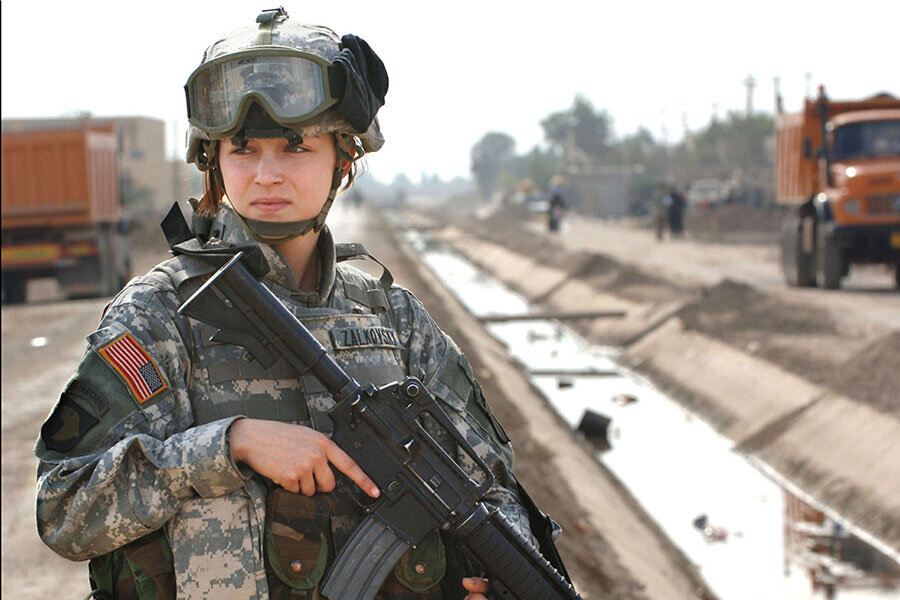Should women now be drafted? Why many women answer 'yes'
Loading...
| Washington
It is perhaps not too surprising that Paris Cervantes would be gung-ho about obliging women to sign up for the draft now that the ban on women in combat is about to be lifted.
She’s an Army staff sergeant and an explosive ordnance device specialist, and she has no doubts about the benefits that women could bring to America’s military in a time of crisis.
“For me, it’s all about equal opportunity,” she says. “Right now, we’re an all-volunteer service, but if the time comes when we need able-bodied Americans,” women should be available, too.
For Louise VanDenburgh, an 18-year-old international affairs major at George Washington University, the prospect is a bit different.
“I would be terrified,” she says.
But without pausing, she notes that’s no different from how many men would feel. And, she adds, these days it seems only fair.
“I would rise to the occasion,” she declares.
As of next month, women will be eligible to join all front-line combat jobs, including the infantry. That change comes with the wider implication that women might now be eligible for the draft, members of Congress have suggested. The House and Senate Armed Services Committees plan to take up the idea next year.
In some ways, the debate is largely a symbolic one – at least for now. That’s because nobody wants the draft – not voters, who are loath to see their children called into battle; not politicians, who would be more accountable to vocal constituents; and especially not the Pentagon, which prefers the all volunteer force put into place after Vietnam, when US military ranks were rife with people who didn’t want to fight.
But it’s by no means inconceivable that a future war could require a draft, and that women could become a part of that calculus. A majority of women, like Sergeant Cervantes and Ms. VanDenburgh, say that’s as it should be.
A 2013 poll by Mason Dixon Polling and Research found that 59 percent of Americans said women should be eligible for the draft. Notably, 61 percent of women said women should be eligible while 57 percent of men did. Gallup polls from 1979 to 2001 showed overall support for women in the draft ranging between 43 percent (1979) and 54 percent (1998).
The decision last week to open combat jobs to women has made the debate more urgent, says Rep. Duncan Hunter (R) of California.
“If you’re going to have women in infantry, you’re going to have to change the Selective Service law,” he told The Wall Street Journal.
In fact, two lawsuits working their way through the courts contend that the draft is discriminatory. The first, filed in California by the National Coalition for Men, argues that the system discriminates against both men and women. Another, filed by a New Jersey mom on behalf of her daughter, says that Selective Service registration discriminates against women.
On this point, many women, both in the military and out, say they tend to agree.
“I know a lot of women, including myself, turned 18 and found out that women weren’t a part of the draft, and we couldn’t believe it,” says 1st Lt. Jill Mueller, a fire support officer commanding a Bradley tank crew. “That should be opened up. The women in our country are so strong, and if the draft were to happen there are so many jobs that women can do.”
Part of that is making women part of a national ethos. “I think there’s something we have in this country where we’re so proud of our men,” she says. “I’d be very happy if it opened to women.”
With the lifting of combat restrictions and potential registration for the draft, it may gradually help change the way the nation views women, adds Cervantes. “It’s like that ‘Run like a girl’ campaign that came out. It was so amazing to me that we’re able to teach the younger generation that being a girl, a woman, shouldn’t be associated with being weak – especially in America.”
On the campus of George Washington University in Washington, women express similar opinions.
“I think it would be more equal,” says Dorothy White, a PhD student. The current male-only requirements for Selective Service “maintains this idea that women are inherently different than men – that men should be the ones doing X and women should be doing Y.”
During the sort of crisis that might prompt a draft, there would be a need for all hands on deck. “They can use scientists, doctors, and that kind of thing in the service, too,” Ms. White says.
“It’s not my dream to do it, but I know for some women it is – and if giving women that opportunity means I have to sign up, then I will.”






